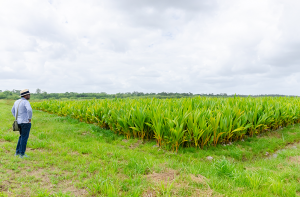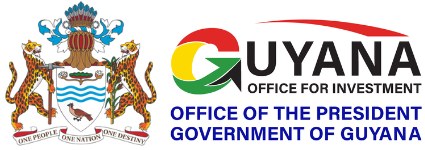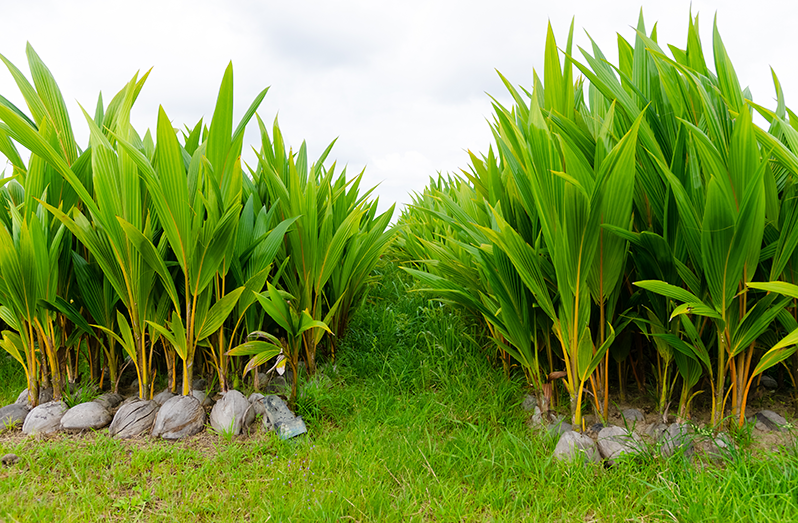Reg. 3 going ‘coco-nuts’ with US $2M project
(By Vishani Ragobeer – Guyana Chronicle)
— local investor seeking to satisfy local, regional and international markets
— value-added products, ecotourism part of long-term development plan
By Vishani Ragobeer
A SHORT speedboat ride across the Demerara River, from Supply on the East Bank of Demerara (EBD), takes you to what is colloquially referred to as “No Man’s Land”. Here, there are large swathes of land with a rich soil composition, which, along with the tropical climate and close proximity to the navigable Demerara River makes it a prime space for large-scale agriculture.
And that is exactly what local trader from Rayo Trades Inc, Rajkumar Outar, has begun using the land for. He has leased about 1000 acres of land, at this area which is located aback the community of Wales on the West Bank Demerara (WBD), Region Three, for the purpose of establishing a coconut plantation.
In a recent visit to the burgeoning plantation, called Riverlands Farms, Outar the Guyana Chronicle was informed by Outar that the establishment of the coconut plantation was a substantial investment pegged at about US $2M. He added that the investment will be made in phases.
As a trader, Outar related that he exports coconuts from smaller scale farmers all across Guyana. Annually, Rayo Trades exports about 200 containers of dry coconuts, with about 60,000 units per container. Altogether, on average, the company exports about 12 million coconuts from Guyana – a sizable feat.

“The birth of the idea actually took place when we saw that we were unable to supply the full demand of coconuts out there,” Outar related, however.
The goal, after that realisation, has been to solidly supply dry coconuts to markets in the Caribbean and even further afield in countries such as the Ivory Coast, India and the Philippines. And, for Outar, this is not unachievable.
Outar currently has a small team of 17 persons, and they have been able to plant about 12,000 seedlings in a nursery and cultivate 200 acres of land thus far. Shortly, cultivation will intensify and the 70,000 coconut trees will sprawl across the 1,000 acres of land. By that, he expects that he will be able to employ between 40 to 100 persons.
Importantly, in an attempt to exploit the land space other cash crops, such as Irish potatoes, passion fruits, avocados and tomatoes, will be planted through an intercropping regime. These cash crops will allow Outar to garner revenues that will aid the sustenance of the plantation, since it will take a few years before the coconut seedlings mature into trees and begin producing the coconuts.
Shortly, in collaboration with the National Agriculture Research and Extension Institute (NAREI) and Ministry of Agriculture, Outar will commence intercropping with Irish potatoes. The seedlings have already been imported and the first yields are expected sometime in mid-2021, as potatoes can be planted and harvested between 90 to 110 days.
VALUE-ADDED PRODUCTS
Eventually, Riverlands farms will also include a small packaging plant. Through this, Outar affirmed that the produce, fresh from the farm, can be supplied to local supermarket chains with which Rayo Trades has a preexisting relationship.

But, beyond that, he sees the coconut as a ‘wonder nut’ that can be exploited. Each part of the coconut has some use, and Outar has already begun thinking about making ropes, mats and other decorative pieces.
“I intend to make my mark on the coconut industry here in Guyana and to put Guyana on the map, where coconuts are concerned,” he said.
Outar’s efforts tie into the national impetus for coconut and general agricultural production. Recently, Minister of Agriculture Zulfikar Mustapha told this newspaper that concerted efforts will be made this year to transform the local coconut industry. The expansion of this industry will begin with further enhancements to the Hope Coconut Industries Limited (HCIL).
Last year, non-traditional agricultural produce earned Guyana over US$12.2 million (G$2.5B) in revenues. Of that sum, the export of dried coconuts earned over $1.6 billion. This product was the largest export, accounting for 8,217 metric tonnes of total exports.
There are about 1,800 farmers in Guyana’s local coconut industry. They collectively cultivate some 24,000 acres of coconut in Regions One, Two, Three, Four, Five, Six and Ten.
Guyana, on average, produces 92 million nuts annually, much of which is exported for coconut copra and water, mainly to Barbados, Trinidad and The Dominican Republic. And, in a few years, the development on the Riverlands Farms is expected to add to this sector.
ECOTOURISM
Beyond agricultural products, Outar has already begun conceptualising plans to transform this coconut plantation into an ecotourism destination also.
He reasoned that the plantation is close to the Cheddi Jagan International Airport (CJIA), and the trip across the Demerara River might prove scenic and enjoyable to tourists. He also imagines constructing a cabin, or two, and allowing persons to explore the space.
“When the canals are clean and the plantation is established, I think it would be a prime location for tourism…. A lot of people out there in the Caribbean do not know what ecotourism is and would like to explore it, and I think here would be a prime location for that,” he said.


